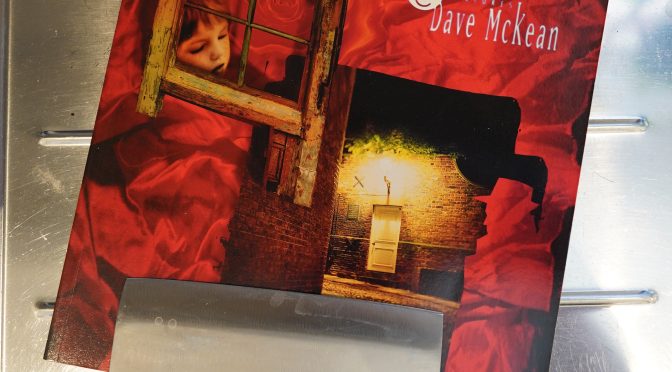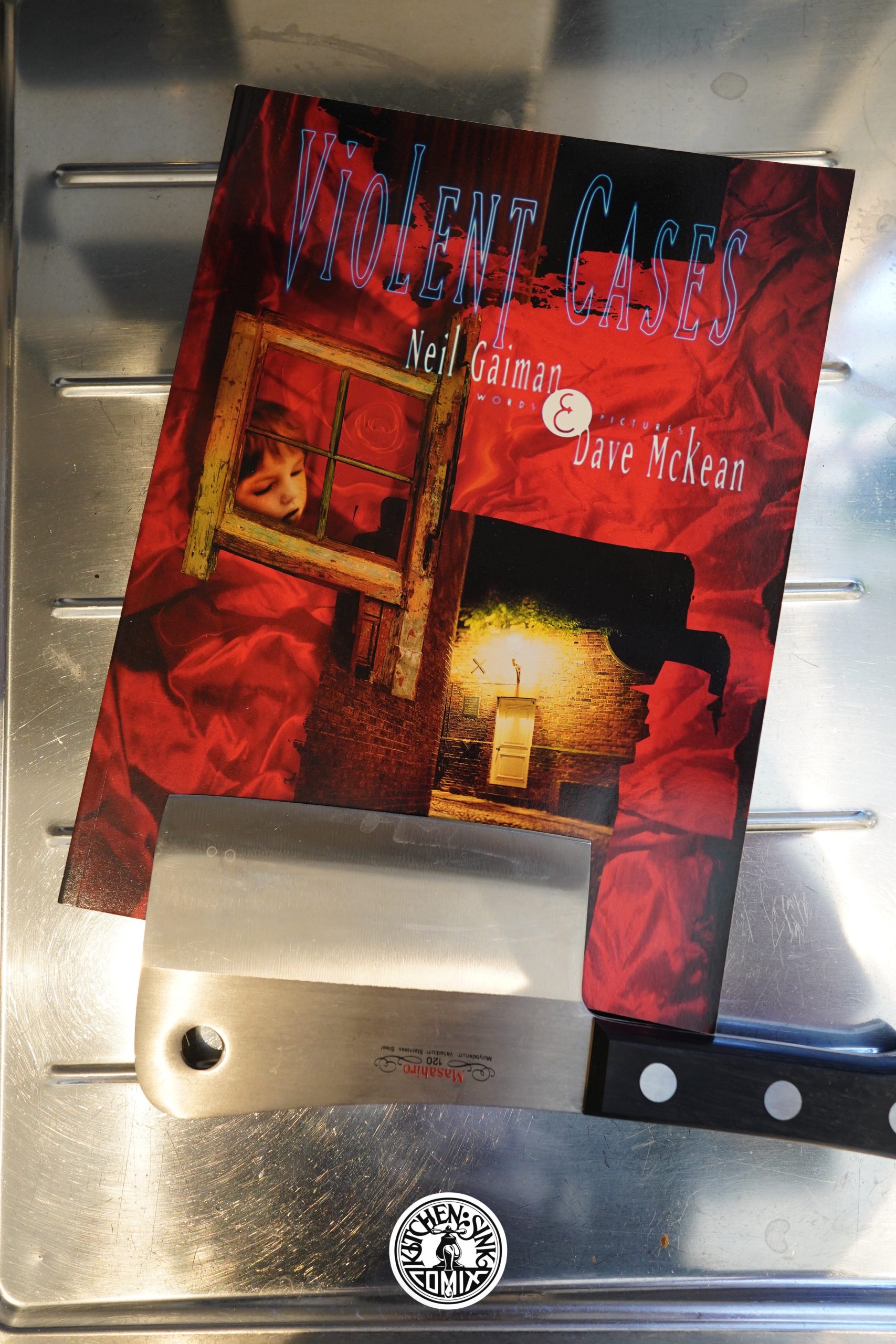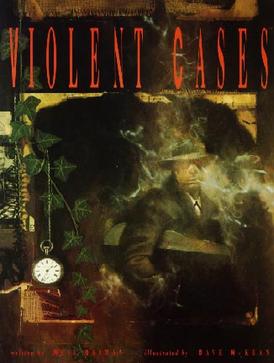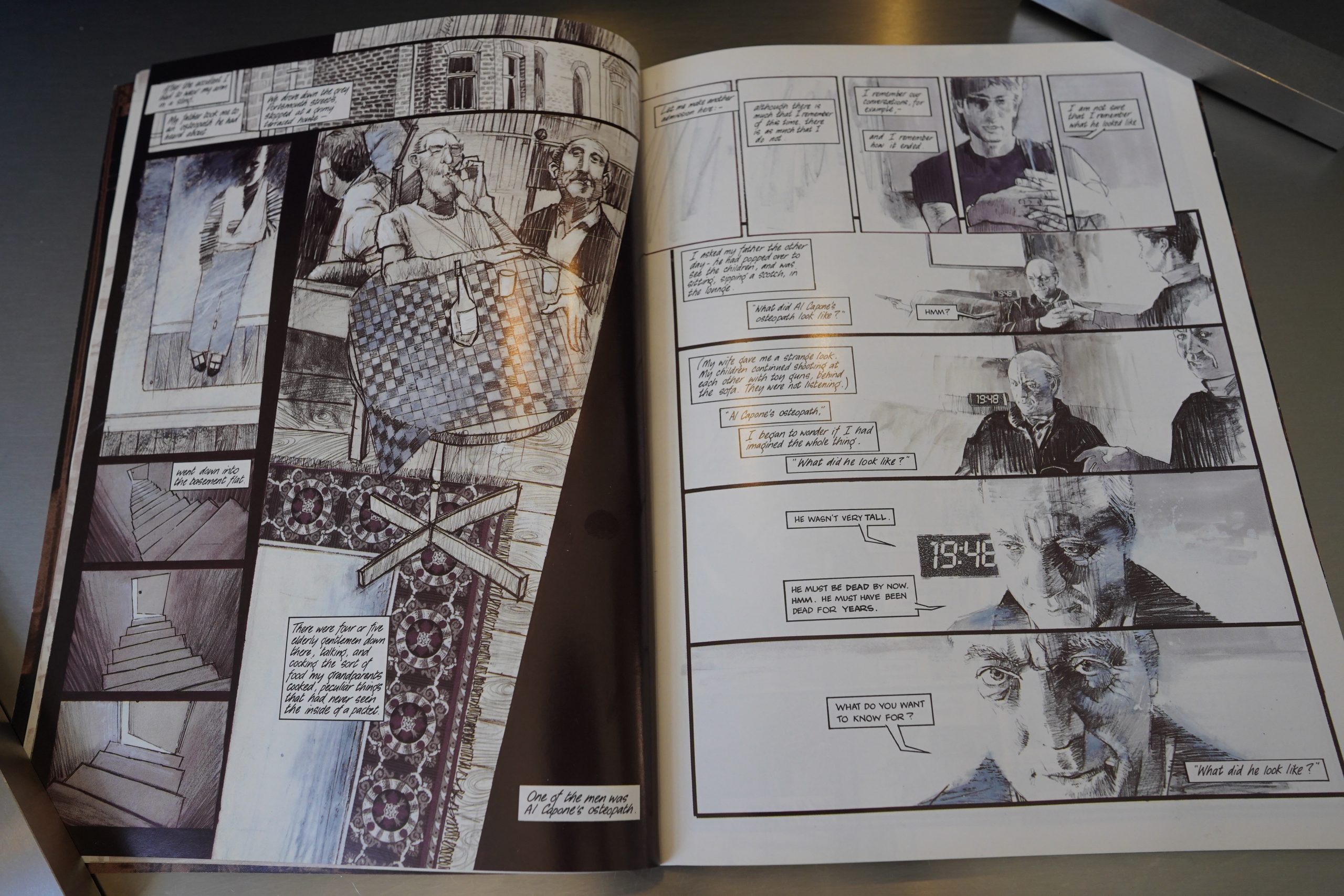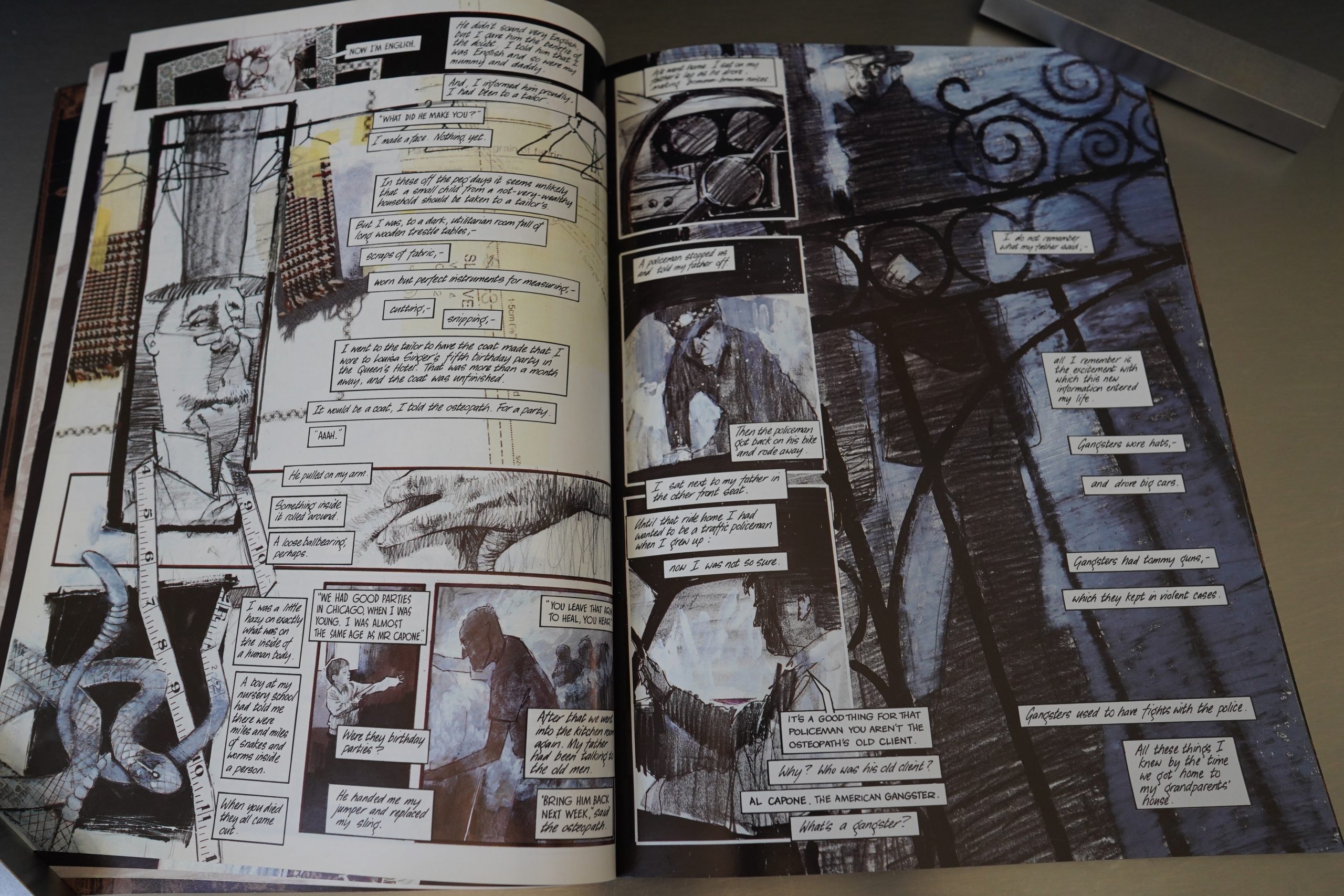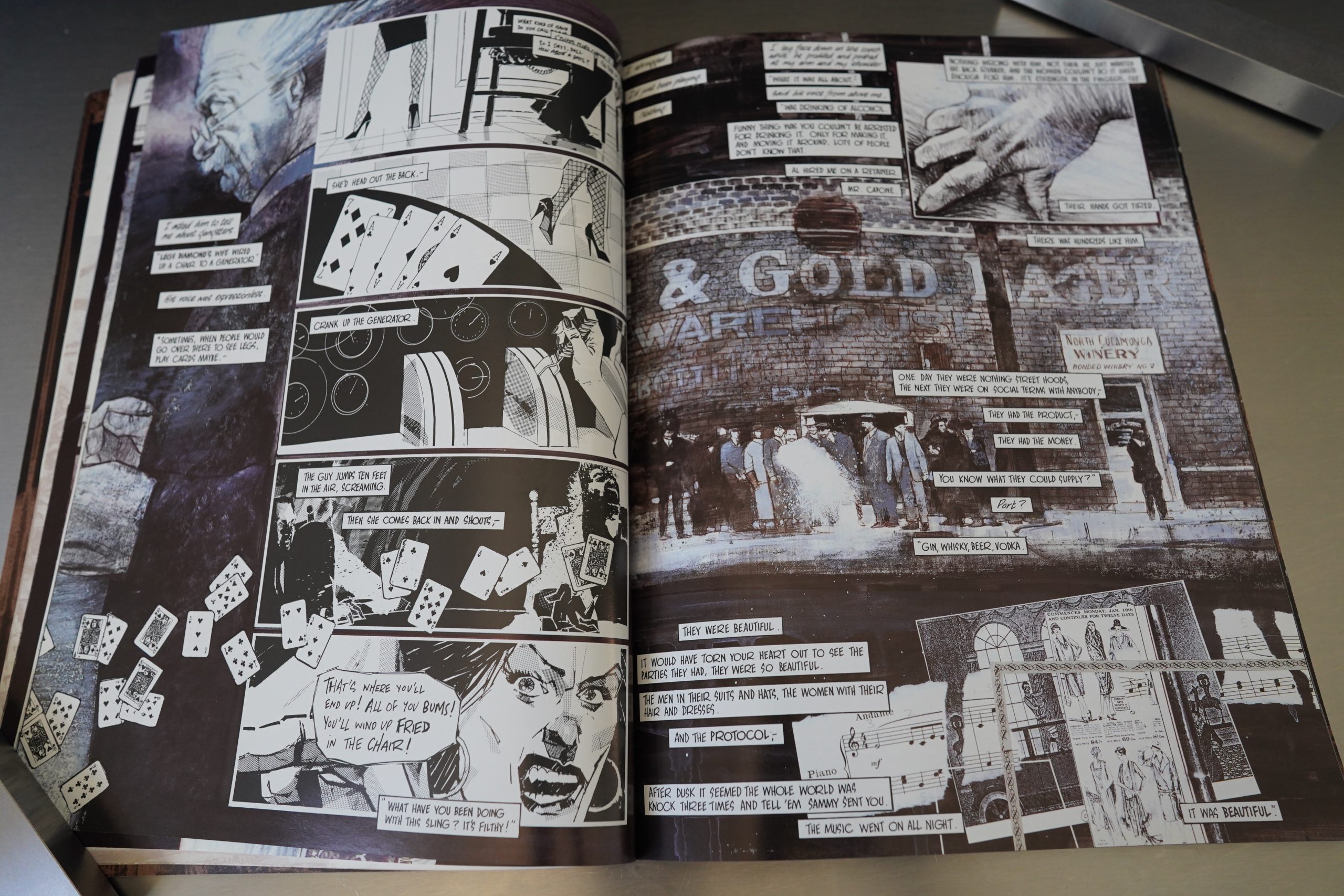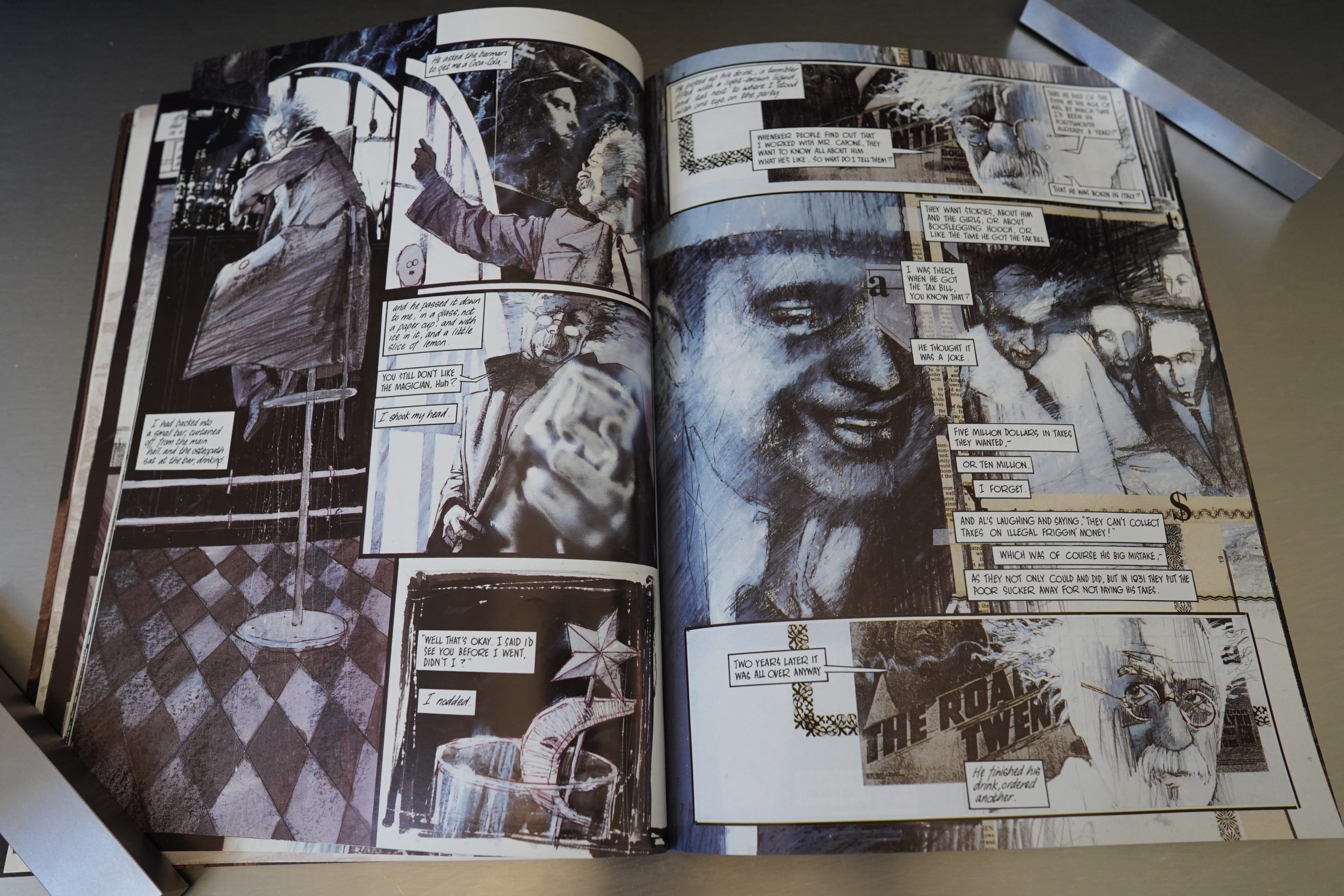Violent Cases (1997) by Neil Gaiman and Dave McKean
I remember buying this back in the 80s (in the British edition that had a much better cover):
But it seems it’s gotten lost over the years, so I bought the Kitchen Sink edition now.
Violent Cases was part of that first wave of “comics aren’t just for children any more” in the late 80s. The wave was the result of basically on three books — Maus, Dark Knight Returns and Watchmen (and how strange it feels to mention those three books in the same sentence at this remove), and publishers and creators were scrambling to Get Product Out To Buyers. I mean, to advance the art form. Ahem.
The scheme crashed and burned, because mainstream audiences were only interested in Maus anyway… but things like Violent Cases got a lot of attention.
Dave McKean’s artwork is pretty good here, but not as good as it would get later. Gaiman keeps the verbiage flowing, though, and it’s not really an excellent use of the comics art form — this could almost (almost) have been a prose story.
But it’s a good read. It has a slight wink wink trickiness to it that’s annoying, and while it purports to be a real memory of Gaiman’s, and problematises the connection between memory and reality, it doesn’t really read anything like a real memory of a four year old.
I haven’t read this since the late 80s, and it’s not as good as I remembered it being. But it’s fine.
Gaiman is interviewed in Comics Scene Volume #2, page 21:
CS: Violent Cases’ starting point is a
real encounter you had as a child
with a man who had been A1
Capone’s osteopath. After that, the
story gets kind of pliable. You look to
be employing an impression of your
memories, rather than portraying
what happened. Those memories
aren’t necessarily accurate, are they?
GAIMAN: If Violent Cases works, 1
think it’s especially because those
memories are not necessarily accu-
rate. What Violent Cases is about is
the pitfalls of memory, the elephant
traps.
A pivotal point in the book is a
scene where A1 Capone beats to death
several other gangsters at a party, and
the whole thing is mostly done from
old film stills. People say, “Why?”
and I say, “Because thaÜs what it was
reconstructed from, in memory.” The
question is, what really happened and
what am I just filling in from films
and TV programs I’ve seen?
That scene never happened liter-
ally; it happened emotionally. Again,
it’s playing with memory. The stories
you get about Capone veer further and
further from the truth, and get
stranger. The very first story you get
in Violent Cases, about Legs
Diamond’s wife,’s having her own
electric chair, is completely true. The
next story, about silver coffins and
stuff, is almost true, but I’ve added to
it and exaggerated here and there. By
the time you get to A1 smashing peo-
ple’s heads in with baseball bats,
we’re way past what was true. The
whole of Violent Cases was con-
structed like that.
CS: You’ve said you write for your-
self, but what kind of readership were
you hoping for with Violent Cases?
GAIMAN: There was a level with
Violent Cases whereby we wanted to
do something accessible. Not neces-
sarily accessible to people who read
comics, but people who simply read,
to people who understand and like
mainstream art. We wanted to do
something that would be as good, and
as easy to hold onto, as anything
outside of comics that didn’t have
people in tights or funny animals; any
of the things that made some of the
very good stuff happening in comics,
like Watchmen and Maus, inaccessi-
ble to people who should have liked
it. Sometimes it’s hard for people to
see past the metaphor; many readers
seem to think Maus trivialized the
Holocaust because it had mice in it.
So, Violent Cases is almost main-
stream, but after a while it goes
beyond the bounds of standard fiction.
The aim was to walk people through a
story to the point where you don’t
even have to suspend disbelief any
more. That was way back. Now
you’re just in a story.
The joy of Violent Cases is you get
the feeling it’s a jigsaw puzzle missing
one vital piece, and you can’t work
out where in the puzzle the piece is
missing. You can go back to it, and
you can go over it and over it, looking
for the card that was palmed when it
was handed to you. You know the ball
was under one of those three cups,
but now you can’t even find the cups.
CS: That was an intentional thing?
GAIMAN: Yes, I think so. The point is
I don’t think you can come to my
work for answers. But you come to
me for some really good questions.
Heh. Gaiman thought that Maus was inaccessible for mainstream audiences? Tee hee.
All: How did the theatrical version
of Violent Cases come about?
GAIMAN: I don’t know an awful lot
about it. You may remember wer here
there was a play version of Halo
Jones. Well, the cast director of that,
Eric Jarvis, got in touch with me and
asked could he do Violent Cases? And
my jaw slightly dropped, and I said,
“As a play? How?” And he said, “As
a one-man show. It’ll be fine. Trust
me.” And I said, “Great, invite me to
the opening night.” So that’s pretty
much where it’s at. From the occa-
sional phone calls I get from him
asking about clarification of textual
details, they do knmv what they’re do-
ing, him and the actor. I’m as eager
to see it as everyone else is. I get to
go to the first night, and if it’s really
good, I get to say, “Yeah, I wrote
that.” If it’s no good at all, I get to
say, “Pity about that, but there’s still
the graphic novel.” It opens at the end
of October over here for two weeks,
and then it’s göing to go on tour in the
new year to coincide with the reissue
of Violent Cases, which is going into
a second edition, which will probably
be printed in America. The impres-
Sion I get from the publisher is that
it’s to keep the American price down.
There’ll probably be a new cover.
Jeffrey Lang writes in Amazing Heroes #200, page 79:
When I learned how to write re-
views, I was instructed to begin by
making a general comment about the
work, then state the positive and
negative points, concentrating on the
negative. That’s very hard to do with
this next piece, because, as hard as I
look, I can’t find anything I don’t like.
Violent Cases is an autobiographical
tale about, among other things, the
reconstruction of memories, the inev-
itable betrayal ofa child by his parents,
the nature of violence, and the horrors
of children’s parties. These ‘are the
facts: when Neil Gaiman was four
years old, his father accidentally
dislocated his. arm. Neil went to an
osteopath for treatment and it torned
out that the osteopath had treated A1
Capone when Capone was at the
height of his power. The osteopath told
Neil stories about Capone and his
associates and the wonderful, terrible
parties they would throw.
A short time later, Neil attended a
child’s birthday party at the Queens’
Hotel. A suspicious-looking magician
began performing, and young Neil
(who, rightfully, does not trust magi-
cians) slipped away from the party,
poetical and though McKean’s art
found a barroom down the way, and
bears some superficial resemblance to
once again encountered the osteopath;
vintage Sienkiewicz, I think that
they talked again. Somewhere in the
McKean is a bit more subtle and
middle of this, Neil relates an event
restrained and knows how to pick a
that occurred when he was sixteen, an
good angle. Though both Gaiman and
encounter with a Great Unexplain-
McKean have gone on to do wilder,
able. This well-orchestrated muddle
more imaginative things (Sandman
of memory is about, as Gaiman states,
and Cages are two outstanding exam-
the events that fall victim to “those bits
ples), Violent Cases will always be,
of one’s memory that simply do not
as Gaiman states in the introduction,
work.”
Ray Mescellado writes in The Comics Journal #149, page 42:
“MY REPUTATION PRECEDES me.”
One usually imagines these words uttered with
an air of droll nonchalance (and probably by
some cheesy James Bond-type villain). But just
think about it: in this age of all-pervasive adver-
tisement and endless self-promotion (“It was
better than Cats, it was better than E.T. , I’m go-
ing to see it again and again and again.. how
can someone (or something) not be preceded
by its reputation? And for the vast majority, I
think Chuck D summed it up best: “Don’t
believe the hype.”
Violent Cases is a graphic album whose rep-
utation preceded it in a big way, at least in the
United States. The reason, though, wasn’t over-
blown hype, but extreme neglect: put simply,
it never received the widespread distribution it
deserved on this side of the Atlantic. Ironically,
it was easier finding British fanzines with ar-
ticles about Violent Cases than it was to get the
book itself. And even after the Stateside suc-
cesses Of Case-workers Neil Gaiman and Dave
McKean (together on Black Orchid and sepa-
rately in Sandman, Arkham Asylum, et al), it’s
taken four years before an American publisher,
Tundra, has finally given this book the distribu-
tion it deserves. They have even gone to the trou-
ble of printing Violent Cases in color for the
first time anywhere.[…]
It’s here that the comparisons between types
of violence reach a masterful pitch: the birth-
day party is played Off against a tale of Capone’s
own “party game” in 1929 — which involved
tying men to chairs and beating them to death
with a baseball bat. The contrasts are remark-
able, especially the way McKean draws them:
he gives the birthday game a light gray haziness,
while Capone’s “game” is done with sharp,
jagged lines and an overwhelming blackness.
The situations are worlds apart — jostling
for a seat to win a game; the brutal murder of
over 20 men. But the narrator puts the seem-
ingly innocuous party game in a different per-
spective: ‘ ‘One child always uound up leaving
in tears.” The final result of musical chairs —
its degeneration “to the level of a vulgar
brawl… while the last chair sat empty, un-
claimed” — leaves one wondering what exactly
separates this game from Capone’s, and how
much they have in common.
So deep!
From this high point, though, the story pro-
ceeds to an unsatisfying climax. The osteopath
sends the narrator back to the party, but the boy
stays behind, hidden. He watches the magician
confront the old man, and three strangers ap-
pear — “Three men in suits so elegant and
str•ange that I could hardly keep from crying out
until I saw the menace in their eyes.” These
strangers are the gangsters the boy had heard
so much of — their reputation preceded them,
and the boy was charmed and awed. The old
man is led away by the men in suits, and the
boy, oblivious to the scene’s significance, returns
to the birthday party.
Gaiman strongly hints about the implausi-
bility of this event, and about the questionable
credibility of the narrator. This scene is pre-
ceded with another of the narrator’s tangents:
how at age 16, a star blinked at him brightly
enough to light the landscape. This smacks of
UFO sightings or experiences, and
he prefaces the incident: “There are these bits
of one’s memory that simply do not work — or
do not work in relationship to the rest of it,
anyway.” He could just as easily be talking atX)ut
the confrontation in the bar.
This is the two hundred and thirtieth post in the Entire Kitchen Sink blog series.
